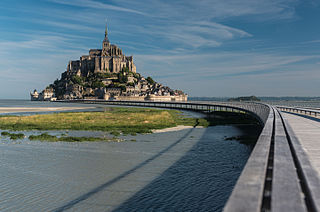
Normandy is a geographical and cultural region in northwestern Europe, roughly coextensive with the historical Duchy of Normandy.

Manche is a coastal French département in Normandy on the English Channel, which is known as La Manche, literally "the sleeve", in French. Manche is bordered by Ille-et-Vilaine and Mayenne to the south, Orne and Calvados to the east, the English Channel to the west and north and by sharing maritime borders with the Crown Dependencies of Bailiwick of Jersey and Bailiwick of Guernsey of the United Kingdom to the west. It had a population of 495,045 in 2019.

Cherbourg is a former commune and subprefecture located at the northern end of the Cotentin peninsula in the northwestern French department of Manche. It was merged into the commune of Cherbourg-Octeville on 28 February 2000, which was merged into the new commune of Cherbourg-en-Cotentin on 1 January 2016.

Lower Normandy is a former administrative region of France. On 1 January 2016, Lower and Upper Normandy merged becoming one region called Normandy.

The Battle of Formigny, fought on 15 April 1450, was a major battle of the Hundred Years' War between England and France. A decisive French victory that destroyed the last significant English field army in Normandy, it paved the way for the capture of their remaining strongholds.

Jean Bureau was a French artillery commander active primarily during the later years of the Hundred Years' War. Along with his brother, Gaspard, he is credited with making French artillery the most effective in the world. As Master Gunner of Artillery in the armies of Charles VII, Bureau acquired a reputation as an effective artillery officer during the Normandy campaign (1449–1450), when his bombardments helped capture the towns of Rouen, Harfleur, and Honfleur, and aided in the French victory at Formigny. Bureau commanded the victorious French army at the decisive Battle of Castillon in 1453.

Valognes is a commune in the Manche department in Normandy in north-western France.

AS Cherbourg or the Association Sportive de Cherbourg Football is a French football team currently playing in Régional 3, the eighth tier of French football, after suffering expulsion from the national leagues in 2023. They are based in the city of Cherbourg-en-Cotentin, Manche in Normandy in north-west France.

The siege of Rouen was a key military engagement of the first French War of Religion. After having been seized by those opposing the crown on 16 April, the siege, beginning on 28 May and culminating on 26 October brought the important city of Rouen back into the crowns control. The fall of Rouen would set the stage for the main battle of the war at Dreux several months later.
Cherbourg – Maupertus Airport or Aéroport de Cherbourg - Maupertus is an airport located 11 km east of Cherbourg-en-Cotentin, between Maupertus-sur-Mer and Gonneville. These are all communes of the Manche département in the Normandy région of France. The airport is managed by SNC-Lavalin Airports since 1 October 2009.
Events from the 1410s in England.
In World War II, the Atlantic pockets were locations along the coasts of the Netherlands, Belgium and France chosen as strongholds by the occupying German forces, to be defended as long as possible against land attack by the Allies.

Normandy is the northwesternmost of the eighteen regions of France, roughly coextensive with the historical Duchy of Normandy.
Cherbourg-Octeville is a former commune in the Manche department in Normandy in north-western France. It was formed when Cherbourg and Octeville merged on 28 February 2000. On 1 January 2016, it was merged into the new commune of Cherbourg-en-Cotentin, of which it became a delegated commune. Its population was 35,338 in 2019.
Amfreville battery was a World War II German artillery battery constructed close to the French village of Querqueville, 5 km (3.1 mi) west of Cherbourg Naval Base, in northwestern France. It formed part of Germany's Atlantic Wall coastal fortifications and protected the western entrance to the port of Cherbourg. The battery engaged British and US ships towards the end of June 1944 before the battery fell to advancing US forces on 26 June 1944.

The siege of Caen took place during the Hundred Years War when English forces under King Henry V laid siege to and captured Caen in Normandy from its French defenders.

The siege of Caen took place in 1450 during the Hundred Years War when French forces laid siege to Caen in the English-controlled Normandy following their decisive victory at the Battle of Formigny.

The siege of Falaise took place in 1450 during the Hundred Years War when French forces laid siege to Falaise in the English-controlled Normandy following their decisive victory at the Battle of Formigny.
The Normandy campaign of 1449-1450 took place during the Hundred Years War when the Kingdom of France undertook a military campaign to retake Normandy from the English. Following the decisive victory of the French at the Battle of Formigny and after the fall of Cherbourg, the last English stronghold in Normandy, English control of Normandy was removed.
The Gascon campaign of 1450-1453 took place during the Hundred Years' War when the kingdom of France undertook a military campaign to invade and cede the Duchy of Gascony from the English. Following the decisive victory of the French at the battle of Castillion and after the fall of Bordeaux, the last English stronghold in Gascony, English control of Gascony was removed.













